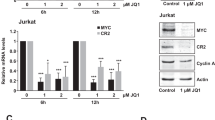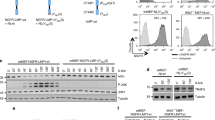Abstract
c-Rel is overexpressed in several B-cell lymphomas and c-rel gene overexpression can transform primary chicken lymphoid cells and induce tumors in animals. Although c-Rel is generally a stronger transcriptional activator than its viral derivative v-Rel, its oncogenic activity is significantly weaker. Among the mutations acquired during c-Rel's evolution into v-Rel are deletion of c-Rel's transactivation domain 2 (cTAD2) and mutations in cTAD1. Given the critical role of the Rel TADs in cell transformation, we investigated how mutations in c-Rel's cTAD1 and cTAD2 contribute to its oncogenicity and that of v-Rel. Mutations in cTAD2 noticeably increased c-Rel's transforming activity by promoting its nuclear localization and gene-specific transactivation, despite an overall decrease in κB site-dependent transactivation potency. Conversely, substitution of vTAD by cTAD1 increased v-Rel's transactivation and transforming efficiencies, whereas its substitution by the stronger cTAD2 compromised activation of mip-1β but not irf-4 and was detrimental to cell transformation. These results suggest that the Rel TADs differentially contribute to gene-specific activation and that an optimal range of transcription potency is necessary for efficient transformation. These findings may have important implications for understanding how Rel TAD mutations can lead to a more oncogenic phenotype.
This is a preview of subscription content, access via your institution
Access options
Subscribe to this journal
Receive 50 print issues and online access
$259.00 per year
only $5.18 per issue
Buy this article
- Purchase on Springer Link
- Instant access to full article PDF
Prices may be subject to local taxes which are calculated during checkout




Similar content being viewed by others
References
Barth TF, Martin-Subero JI, Joos S, Menz CK, Hasel C, Mechtersheimer G et al. (2003). Gains of 2p involving the REL locus correlate with nuclear c-Rel protein accumulation in neoplastic cells of classical Hodgkin lymphoma. Blood 101: 3681–3686.
Capobianco AJ, Simmons DL, Gilmore TD . (1990). Cloning and expression of a chicken c-rel cDNA: unlike p59v-rel, p68c-rel is a cytoplasmic protein in chicken embryo fibroblasts. Oncogene 5: 257–265.
Carrasco D, Cheng J, Lewin A, Warr G, Yang H, Rizzo C et al. (1998). Multiple hemopoietic defects and lymphoid hyperplasia in mice lacking the transcriptional activation domain of the c-Rel protein. J Exp Med 187: 973–984.
Chen C, Agnès F, Gélinas C . (1999). Mapping of a serine-rich domain essential for the transcriptional, antiapoptotic, and transforming activities of the v-Rel oncoprotein [published erratum appears in Mol Cell Biol 2001; 21: 7115]. Mol Cell Biol 19: 307–316.
Cogswell PC, Guttridge DC, Funkhouser WK, Baldwin Jr AS . (2000). Selective activation of NF-κB subunits in human breast cancer: potential roles for NF-κB2/p52 and for Bcl-3. Oncogene 19: 1123–1131.
Diehl JA, McKinsey TA, Hannink M . (1993). Differential pp40IκB-β inhibition of DNA binding by Rel proteins. Mol Cell Biol 13: 1769–1778.
Fan Y, Rayet B, Gélinas C . (2004). Divergent C-terminal transactivation domains of Rel/NF-κB proteins are critical determinants of their oncogenic potential in lymphocytes. Oncogene 23: 1030–1042.
Feuerhake F, Kutok JL, Monti S, Chen W, LaCasce AS, Cattoretti G et al. (2005). NFkappaB activity, function, and target-gene signatures in primary mediastinal large B-cell lymphoma and diffuse large B-cell lymphoma subtypes. Blood 106: 1392–1399.
Gilmore TD . (1999). Multiple mutations contribute to the oncogenicity of the retroviral oncoprotein v-Rel. Oncogene 18: 6925–6937.
Gilmore TD, Cormier C, Jean-Jacques J, Gapuzan ME . (2001). Malignant transformation of primary chicken spleen cells by human transcription factor c-Rel. Oncogene 20: 7098–7103.
Gilmore TD, Kalaitzidis D, Liang MC, Starczynowski DT . (2004). The c-Rel transcription factor and B-cell proliferation: a deal with the devil. Oncogene 23: 2275–2286.
Hannink M, Temin HM . (1989). Transactivation of gene expression by nuclear and cytoplasmic Rel proteins. Mol Cell Biol 9: 4323–4336.
Hrdlicková R, Nehyba J, Bose Jr HR . (2001). Interferon regulatory factor-4 contributes to transformation of v-Rel-expressing fibroblasts. Mol Cell Biol 21: 6369–6386.
Hrdlicková R, Nehyba J, Humphries EH . (1994a). In vivo evolution of c-rel oncogenic potential. J Virol 68: 2371–2382.
Hrdlicková R, Nehyba J, Humphries EH . (1994b). v-Rel induces expression of three avian immunoregulatory surface receptors more efficiently than c-Rel. J Virol 68: 308–319.
Iwai K, Lee BR, Hashiguchi M, Fukushima A, Iwashima M . (2005). IκB-alpha-specific transcript regulation by the C-terminal end of c-Rel. FEBS Lett 579: 141–144.
Kalaitzidis D, Davis RE, Rosenwald A, Staudt LM, Gilmore TD . (2002). The human B-cell lymphoma cell line RC-K8 has multiple genetic alterations that dysregulate the Rel/NF-κB signal transduction pathway. Oncogene 21: 8759–8768.
Kamens J, Richardson P, Mosialos G, Brent R, Gilmore T . (1990). Oncogenic transformation by v-Rel requires an amino-terminal activation domain. Mol Cell Biol 10: 2840–2847.
Kralova J, Liss AS, Bargmann W, Pendleton C, Varadarajan J, Ulug E et al. (2002). Differential regulation of the inhibitor of apoptosis ch-IAP1 by v-rel and the proto-oncogene c-rel. J Virol 76: 11960–11970.
Kralova J, Schatzle JD, Bargmann W, Bose Jr HR . (1994). Transformation of avian fibroblasts overexpressing the c-rel proto-oncogene and a variant of c-rel lacking 40 C-terminal amino acids. J Virol 68: 2073–2083.
Martin AG, Fresno M . (2000). Tumor necrosis factor-alpha activation of NF-kappaB requires the phosphorylation of Ser-471 in the transactivation domain of c-Rel. J Biol Chem 275: 24383–24391.
Nehyba J, Hrdlicková R, Bose Jr HR . (1997). Differences in kappaB DNA-binding properties of v-Rel and c-Rel are the result of oncogenic mutations in three distinct functional regions of the Rel protein. Oncogene 14: 2881–2897.
Nehyba J, Hrdlicková R, Humphries EH . (1994). Evolution of the oncogenic potential of v-rel: rel-induced expression of immunoregulatory receptors correlates with tumor development and in vitro transformation. J Virol 68: 2039–2050.
Petrenko O, Ischenko I, Enrietto PJ . (1997). Characterization of changes in gene expression associated with malignant transformation by the NF-kappaB family member, v-Rel. Oncogene 15: 1671–1680.
Rayet B, Fan Y, Gélinas C . (2003). Mutations in the v-Rel transactivation domain indicate altered phosphorylation and identify a subset of NF-κB-regulated cell death inhibitors important for v-Rel transforming activity. Mol Cell Biol 23: 1520–1533.
Rayet B, Gélinas C . (1999). Aberrant rel/nfκb genes and activity in human cancer. Oncogene 18: 6938–6947.
Romieu-Mourez R, Kim DW, Shin SM, Demicco EG, Landesman-Bollag E, Seldin DC et al. (2003). Mouse mammary tumor virus c-rel transgenic mice develop mammary tumors. Mol Cell Biol 23: 5738–5754.
Savage KJ, Monti S, Kutok JL, Cattoretti G, Neuberg D, De Leval L et al. (2003). The molecular signature of mediastinal large B-cell lymphoma differs from that of other diffuse large B-cell lymphomas and shares features with classical Hodgkin lymphoma. Blood 102: 3871–3879.
Sovak MA, Bellas RE, Kim DW, Zanieski GJ, Rogers AE, Traish AM et al. (1997). Aberrant NF-kappaB/Rel expression and the pathogenesis of breast cancer. J Clin Invest 100: 2952–2960.
Starczynowski DT, Reynolds JG, Gilmore TD . (2003). Deletion of either C-terminal transactivation subdomain enhances the in vitro transforming activity of human transcription factor REL in chicken spleen cells. Oncogene 22: 6928–6936.
Starczynowski DT, Reynolds JG, Gilmore TD . (2005). Mutations of tumor necrosis factor alpha-responsive serine residues within the C-terminal transactivation domain of human transcription factor REL enhance its in vitro transforming ability. Oncogene 24: 7355–7368.
Starczynowski DT, Trautmann H, Pott C, Harder L, Arnold N, Africa JA et al. (2006). Mutation of an IKK phosphorylation site in the transactivation domain of REL in two patients with B-cell lymphoma enhances REL's in vitro transforming activity. Oncogene October 30; [Epub ahead of print].
Acknowledgements
We are grateful to T Gilmore, H Bose, A Liss, R Hrdlicková, A Rabson and C Abate-Shen for reagents and protocols. This work was supported by NIH Grant CA54999 to CG.
Author information
Authors and Affiliations
Corresponding author
Additional information
Note added in proof In agreement with our findings, Starczynowski et al. recently reported a naturally occurring mutation in the TAD of human c-Rel (Ser 525Pro) in two patients with B-cell lymphoma, that decreased its transcription potency and increased its transforming activity (Starczynowski et al., 2006).
Supplementary Information accompanies the paper on the Oncogene website (http://www.nature.com/onc).
Supplementary information
Rights and permissions
About this article
Cite this article
Fan, Y., Gélinas, C. An optimal range of transcription potency is necessary for efficient cell transformation by c-Rel to ensure optimal nuclear localization and gene-specific activation. Oncogene 26, 4038–4043 (2007). https://doi.org/10.1038/sj.onc.1210164
Received:
Revised:
Accepted:
Published:
Issue Date:
DOI: https://doi.org/10.1038/sj.onc.1210164



